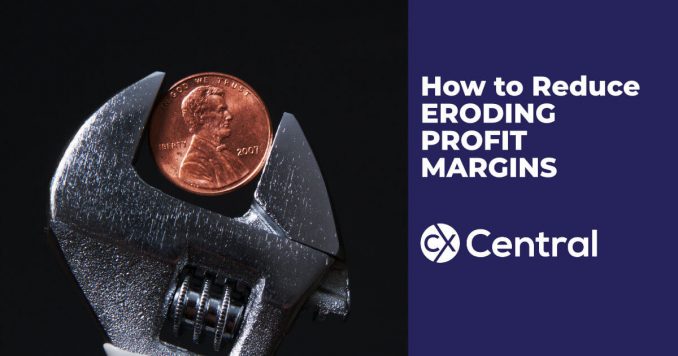
Top tips on improving your profit margins
How selling fear and hope can help
Profit margins in most industries are decreasing.
Some quite markedly.
Fifteen years ago the retail profit margin on computer hardware was close to 50%, today it is less than 10%.
Fifteen years ago real estate salespeople were getting at least 3% commission on the sale of a property, today it is 2% if they are lucky.
In ten years it will probably be 1%.
In many industries, I can buy goods online that retailers would have to sell at a loss if they were to match the price.
Why is this happening and what can be done to arrest the decline?
The “why” is simple and is self-inflicted. The “how to arrest the decline” is also simple and is within the ability of each of us.
The reason profit margins have eroded is because players in each affected industry have commoditised their offer and made price the only differentiator in their marketing.
Industry examples
Take the travel industry.
Years ago we would go to the travel agent and discuss the excitement and possibilities of our future overseas trip.
The discussion would be on the experiences and adventures we might have and the consultant’s advice would play a big part in the decision we made.
Today, it is all about cheap airfares on the internet and we don’t seek the advice of the travel consultant because tripadvisor.com gives us information which is more powerful – feedback from other travellers, and we make our decisions accordingly.
What about the car industry?
Almost every car dealer advertises they will match the price of any competitive offer.
It used to be that Ford’s biggest competitor was Holden, now a Ford dealer’s biggest competitor is another Ford dealer and a Toyota dealer’s biggest competitor is another Toyota dealer because the car has become a “commodity”.
How is that affecting the industry?
Thirty years ago a car dealership was a hugely profitable business and many multi-millionaires were made from selling cars.
Today, the sons of those multi-millionaire car dealers have taken over the business and struggle to service their mortgage because there is little profitability in selling cars these days.
I was at a conference of a major motor vehicle company and they announced to the dealer principals in the room that dealer profitability on new cars nationally for the whole brand was HALF OF ONE PERCENT.
There are many, many other examples of industries that have given their margins away and are now blaming the consumer for being price-preoccupied and complaining that they can’t make any money.
The more interesting question is how can this decline be arrested and what can business people do to get the margin back into their business?
How to increase your profit margins
I have a simple answer to this dilemma that I have seen clever companies use in their businesses.
I use it in my business and you can use it in yours.
You need to sell an INTANGIBLE and not a commodity!
People will pay more for an intangible than they will for a commodity, even if the product concerned is identical.
Let me give you several examples.
Example number 1 – CRIMSAFE
CRIMSAFE is a company that sells security screen doors and it has quite a few competitors.
About five years ago they ran one of the best radio advertising campaigns I have ever heard.
The voiceover said something like “Imagine what it would be like if someone broke into your house and hurt the people you love the most”.
There was a pause so the listener could imagine something terrible happening to their loved ones.
Then the voiceover continued “CRIMSAFE. Makers of the best security screen doors in Australia”.
And sales skyrocketed.
Why? Because CRIMSAFE stopped selling screen doors which are a commodity and started selling FEAR which is an intangible.
And people will pay much more to avert their fear than they will pay for screen doors.
When our children were young, my wife and I were planning an overseas trip to celebrate a landmark birthday, leaving the children with a live-in nanny for two weeks.
A month before we were due to leave, someone broke into our house while we were asleep and stole cash from our bedroom.
We made the decision the next day that we would not travel overseas if we didn’t have the best security screen doors on our home to ensure the safety of our children.
And we bought those screen doors and we didn’t care what we paid.
The people in the security screen door industry say the best thing for their business is when people get their home broken into.
It creates the demand for their product and price is rarely an issue.
CRIMSAFE worked out the second-best thing.
And that is to plant the image in the consumer’s mind of the fear that something bad might happen to them and offer CRIMSAFE as the solution to the problem.
And that’s what they did.
Margins in the FEAR industry do not erode!
What intangible does the expensive nursing home sell to the children of the prospective resident of that home, knowing that the costs of looking after that resident will come from the children’s future inheritance?
If you can’t get it yet, let me make it easier.
Imagine the salesperson from the nursing home saying “After all your mother/father has done for you, don’t you think they deserve the best of everything in their final years?”
They are selling GUILT.
Of course, they are. And guilt sells!
Example number 2 – The Wedding Photographer
I have a friend who is a retired wedding photographer.
His fees were usually up to 50% higher than his nearest competitor.
His strategy which had a 90% conversion rate?
After he presented the father of the prospective bride with the quote (which usually led to a jaw-dropping), he looked him in the eye while the mother of the bride and the future bride, herself, looked on, and he said: “Do you love your daughter enough to have the best of everything on the most important day of her life?”
And then he just paused and waited for the reply which was YES in over 90% of cases.
You can make much more money selling GUILT than you can selling photography.
It can work in just about any industry.
Example number 3 – Cosmetics
I got my own personal strategy from the cosmetics industry.
Do you know what REVLON and other cosmetics companies sell?
They sell HOPE to women!
It may not be in their public mission statement but you can bet their marketing people understand it.
And that is why cosmetics that cost $75 for a small bottle of goo sell better than cosmetics that cost $20.
Because there is more HOPE in an expensive bottle than there is a cheap one.
And when you link that with a celebrity who endorses the product, you get the consumer making the irrational (but profitable for the cosmetics company) decision that if they buy that $75 bottle of goo, they can look more like that beautiful celebrity.
Example number 4 – Golf
Men are suckers too!
If you are a man and you are now laughing about how vain and stupid women must be to fall for that, how do you think the golf industry works?
It has been said by more than one golf equipment marketing executive that “golf is a multi-billion dollar industry based on irrational hope”.
NIKE can sell expensive golf clubs to hacker golfers with minimal ability (but lots of money) on the ridiculous premise that, by buying those clubs, they will be using the clubs that Tiger Woods and Rory McIlroy uses and they will play a bit more like them.
Unbelievable? Yes.
Effective? Also yes.
HOPE is also what every consultant sells.
It’s just that most of them don’t know that’s what they are selling.
And I can make more money selling hope than selling a 60-minute presentation at a conference.
How do I do it?
I make my testimonials the centrepiece of my marketing.
I have a page of about 40 testimonials on my website and while some of them talk about the humour in my presentation and the work I did in customising my message to the audience, the overwhelming impression to a person who reads some or all of them is “These people were really happy with their decision to engage Martin’s services” and I am urging them to HOPE (and believe) that if they hire my services, they will feel the same way after THEIR conference.
If I sell an hour of my time, that’s a commodity, if I sell the hope that the CEO of my client company will feel he/she has made a good decision, that’s an intangible and is harder to put a price on.
What we must do as salespeople who value our margins, is get focus on the result rather than the product/service.
An hour of my time is worth $X and can be undercut by a competitor offering an hour of his/her time cheaper.
The CEO picturing the good feeling after the conference (like so many others have had) and calculating the return on investment by his people changing their behaviour as a result of my influence – that has to be worth much, much more. And it is.
What are you doing in your industry? Are you selling a commodity or an intangible?
Commodity or intangible?
Indulge my humorous side for a moment.
Here’s how a retail shopping centre would look if retailers sold intangibles instead of commodities.
The jeweller wouldn’t have “50% off” in the window, he/she would have a sign that says MEN: ARE YOU TAKING YOUR RELATIONSHIP FOR GRANTED? BUY YOUR PARTNER SOME JEWELLERY BEFORE SOMEONE ELSE DOES AND YOU LOSE HER FOREVER.
The optometrist wouldn’t have “Buy one get one free” in the window he/she would have THINKING OF GETTING MARRIED? COME IN FOR AN EYE TEST. YOU MIGHT CHANGE YOUR MIND.
The pet shop wouldn’t have “Puppies half price”, it would have PARENTS: IF YOU DON’T BUY YOUR CHILDREN A PET, THEY WILL REMEMBER IT FOREVER AND THEY MAY NOT DO EVERYTHING THEY CAN FOR YOU WHEN YOU ARE OLD AND DEPENDANT ON THEM.
Obviously, I am being facetious with the above examples BUT if they were the type of signs in the window rather than “SALE” or “50% OFF” which seems to dominate the retail landscape, don’t you think the retailers’ margins may be a bit better than they are?
The final challenge
My challenge to those of you who are in industries whose margins have eroded is to shift focus.
If you take the two industries I quoted at the start of this article, if real estate agents were selling STRESS MANAGEMENT to vendors, then commissions may go back to 3% instead of down to 1% where they are heading at the moment.
Other computer companies should learn from APPLE who got out of the computer industry years ago and got into the ENTERTAINMENT industry which is much harder to put a value on.
And if you are lucky enough to be in an industry that isn’t suffering from eroding margins, you are probably selling intangibles already but if you aren’t, do it before your competitors do because there is no reason why healthy margins can’t be maintained or improved upon if you provide the right solutions.
I hope the above is helpful and I look forward to Saturday when I can enjoy my game of HOPE, I mean golf.
Recommended further reading: How to create a customer-centric culture
Find a list of suppliers who specialise in helping Australian Businesses improve their customer service delivery including outsourcers, consultants, technology suppliers and more on the free CX Directory >>>


Be the first to comment